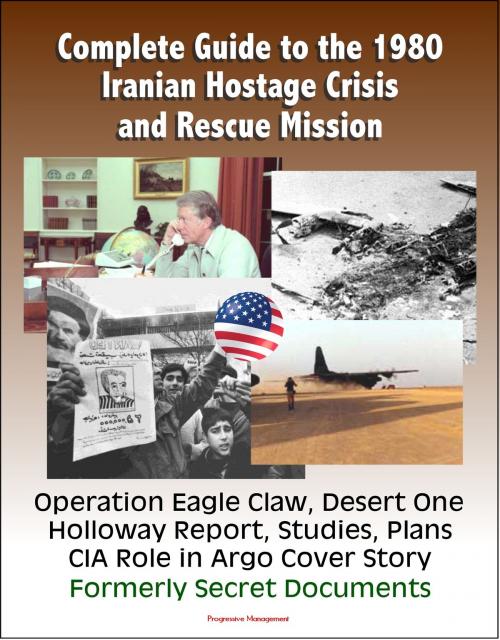Complete Guide to the 1980 Iranian Hostage Crisis and Rescue Mission, Operation Eagle Claw, Desert One, Holloway Report, Studies, Plans, CIA Role in Argo Cover Story, Formerly Secret Documents
Nonfiction, History, Middle East, Military| Author: | Progressive Management | ISBN: | 9781301948260 |
| Publisher: | Progressive Management | Publication: | September 3, 2013 |
| Imprint: | Smashwords Edition | Language: | English |
| Author: | Progressive Management |
| ISBN: | 9781301948260 |
| Publisher: | Progressive Management |
| Publication: | September 3, 2013 |
| Imprint: | Smashwords Edition |
| Language: | English |
This massive ebook provides encyclopedic coverage of the Iranian hostage crisis during the Carter administration and the 1980 failed military rescue mission with declassified Department of Defense documents, intelligence reports, histories and reports. These reports provide important new information on this controversy. There is extensive coverage of military activities, including the planning and execution of the hostage rescue mission called Operation Eagle Claw, which resulted in the Desert One tragedy on April 25, 1980. There is also new information on planning for Operation Snowbird later in 1980. Contents:
Part 1: Overview
Part 2: Iran Hostage Rescue Mission Report (The Holloway Report)
Part 3: Robert Ode Hostage Diary
Part 4: Statements by Defense Secretary Brown and JSC Chairman Jones
Part 5: Crisis in Iran - Operation Eagle Claw
Part 6: The Iranian Hostage Rescue Mission - A Case Study
Part 7: Two White Houses - The Iran Hostage Crisis
Part 8: Choosing Peace: Jimmy Carter and the Iran Hostage Crisis
Part 9: A Classic Case of Deception - CIA Goes Hollywood, The Argo Cover Story
Part 10: Broken Stiletto - Command and Control of the Joint Task Force During Operation Eagle Claw at Desert One
Part 11: Desert One: The Hostage Rescue Mission
Part 12: Operation Eagle Claw - Lessons Learned
Part 13: Disaster at Desert One: Catalyst for Change
Part 14: The Iranian Hostage Rescue Attempt
Part 15: Iranian Hostage Rescue Attempt - A Case Study
Part 16: Skipping the Interagency Process Can Mean Courting Disaster: The Case of Desert One
Part 17: Explaining Iran's Foreign Policy, 1979-2009
Part 18: USSOCOM Mission
Part 19: From Son Tay to Desert One: Lessons Unlearned
Part 20: Airborne Raids - A Potent Weapon in Countering Transnational Terrorism
Part 21: Command and Control of Special Operations Forces Missions in the U.S. Northern Command Area of Responsibility
Part 22: Excerpt about Desert One from The Praetorian STARShip: The Untold Story of the Combat Talon
Part 23: Original Documents
On November 4, 1979, more than 3,000 Iranian militant students stormed the American Embassy in Tehran, Iran. 66 Americans were seized and held hostage, precipitating a confrontation with the United States. The result of this crisis would change the course of a presidency, and affect the relations between the two nations. In military history one can stand out as a splendid example or a disastrous reminder. The brave men who attempted to rescue American hostages in Iran in April of 1980 unfortunately became a disastrous reminder of the need for unity of command, joint training, and good communications, and the dangers of overly complex and needlessly compartmented planning. The failure of their mission, Operation Eagle Claw, would be a prime motivator in the subsequent formation of US Special Operations Command.
On April 24, 1980, highly-trained members of the four armed services made a valiant attempt to rescue the 44 diplomats and servicemembers held hostage in the Islamic republic of Iran. What the vast majority of Americans did not know was that planning for an armed rescue attempt began almost immediately after the embassy was overrun. The code name for the overall operation was Rice Bowl, while the operational portion was known as Eagle Claw. The operation was complex and faced several limiting factors, among which were the relative isolation of Tehran and the available courses of action which involved an increased risk of equipment failure. One critical piece of the operation was a refueling and overnight stay at a mid-desert site named Desert One. When the operation finally launched on the night of April 24, 1980, equipment failures and unpredictable dust storms caused the on-scene commanders to abort the mission. As the rescue force prepared to evacuate Desert One, an H-53 helicopter collided with a C-130.
This massive ebook provides encyclopedic coverage of the Iranian hostage crisis during the Carter administration and the 1980 failed military rescue mission with declassified Department of Defense documents, intelligence reports, histories and reports. These reports provide important new information on this controversy. There is extensive coverage of military activities, including the planning and execution of the hostage rescue mission called Operation Eagle Claw, which resulted in the Desert One tragedy on April 25, 1980. There is also new information on planning for Operation Snowbird later in 1980. Contents:
Part 1: Overview
Part 2: Iran Hostage Rescue Mission Report (The Holloway Report)
Part 3: Robert Ode Hostage Diary
Part 4: Statements by Defense Secretary Brown and JSC Chairman Jones
Part 5: Crisis in Iran - Operation Eagle Claw
Part 6: The Iranian Hostage Rescue Mission - A Case Study
Part 7: Two White Houses - The Iran Hostage Crisis
Part 8: Choosing Peace: Jimmy Carter and the Iran Hostage Crisis
Part 9: A Classic Case of Deception - CIA Goes Hollywood, The Argo Cover Story
Part 10: Broken Stiletto - Command and Control of the Joint Task Force During Operation Eagle Claw at Desert One
Part 11: Desert One: The Hostage Rescue Mission
Part 12: Operation Eagle Claw - Lessons Learned
Part 13: Disaster at Desert One: Catalyst for Change
Part 14: The Iranian Hostage Rescue Attempt
Part 15: Iranian Hostage Rescue Attempt - A Case Study
Part 16: Skipping the Interagency Process Can Mean Courting Disaster: The Case of Desert One
Part 17: Explaining Iran's Foreign Policy, 1979-2009
Part 18: USSOCOM Mission
Part 19: From Son Tay to Desert One: Lessons Unlearned
Part 20: Airborne Raids - A Potent Weapon in Countering Transnational Terrorism
Part 21: Command and Control of Special Operations Forces Missions in the U.S. Northern Command Area of Responsibility
Part 22: Excerpt about Desert One from The Praetorian STARShip: The Untold Story of the Combat Talon
Part 23: Original Documents
On November 4, 1979, more than 3,000 Iranian militant students stormed the American Embassy in Tehran, Iran. 66 Americans were seized and held hostage, precipitating a confrontation with the United States. The result of this crisis would change the course of a presidency, and affect the relations between the two nations. In military history one can stand out as a splendid example or a disastrous reminder. The brave men who attempted to rescue American hostages in Iran in April of 1980 unfortunately became a disastrous reminder of the need for unity of command, joint training, and good communications, and the dangers of overly complex and needlessly compartmented planning. The failure of their mission, Operation Eagle Claw, would be a prime motivator in the subsequent formation of US Special Operations Command.
On April 24, 1980, highly-trained members of the four armed services made a valiant attempt to rescue the 44 diplomats and servicemembers held hostage in the Islamic republic of Iran. What the vast majority of Americans did not know was that planning for an armed rescue attempt began almost immediately after the embassy was overrun. The code name for the overall operation was Rice Bowl, while the operational portion was known as Eagle Claw. The operation was complex and faced several limiting factors, among which were the relative isolation of Tehran and the available courses of action which involved an increased risk of equipment failure. One critical piece of the operation was a refueling and overnight stay at a mid-desert site named Desert One. When the operation finally launched on the night of April 24, 1980, equipment failures and unpredictable dust storms caused the on-scene commanders to abort the mission. As the rescue force prepared to evacuate Desert One, an H-53 helicopter collided with a C-130.















